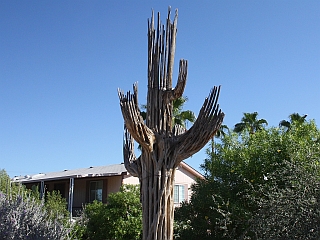 How about a good, but not scary, ghost story for Halloween?
How about a good, but not scary, ghost story for Halloween?
From WikiPedia (edited):
The saguaro, pronounced suh-HWAR-o, (Carnegiea gigantea) is a large, tree-sized cactus species in the monotypic genus Carnegiea. It is native to the Sonoran Desert in Arizona, the Mexican state of Sonora, and an extremely small area of California. The saguaro blossom is the state flower of Arizona.
The common name saguaro came into the English language through the Spanish language, originating in the language of the Tohono O’odham native American nation. Saguaros can grow to forty-five feet tall and ten feet in circumference.
The ribs of the saguaro were used for construction and other purposes by Native Americans. A fine example can be seen in the roofing of the cloisters of the Mission San Xavier del Bac on the Tohono O’odham lands near Tucson, Arizona. The Seri people of northwestern Mexico used the plant which they call mojépe for a number of purposes.
When a saguaro dies, the woody support ribs remain after the flesh decays or is consumed. What you see in the image (click to enlarge) is the ghost (skeleton, maybe?) of a saguaro in Apache Junction, AZ.

Withered, dried up?
Skeleton like?
Oppressive?
Silent, brooding but yet accusatory?
Sounds like the dreaded Cacti d’Mother-In-Law
More like the dreaded “Speaker-of-the-House” Cactus, I’d say . . .
Heh, true dat. Cacti Pelosi d’Morta